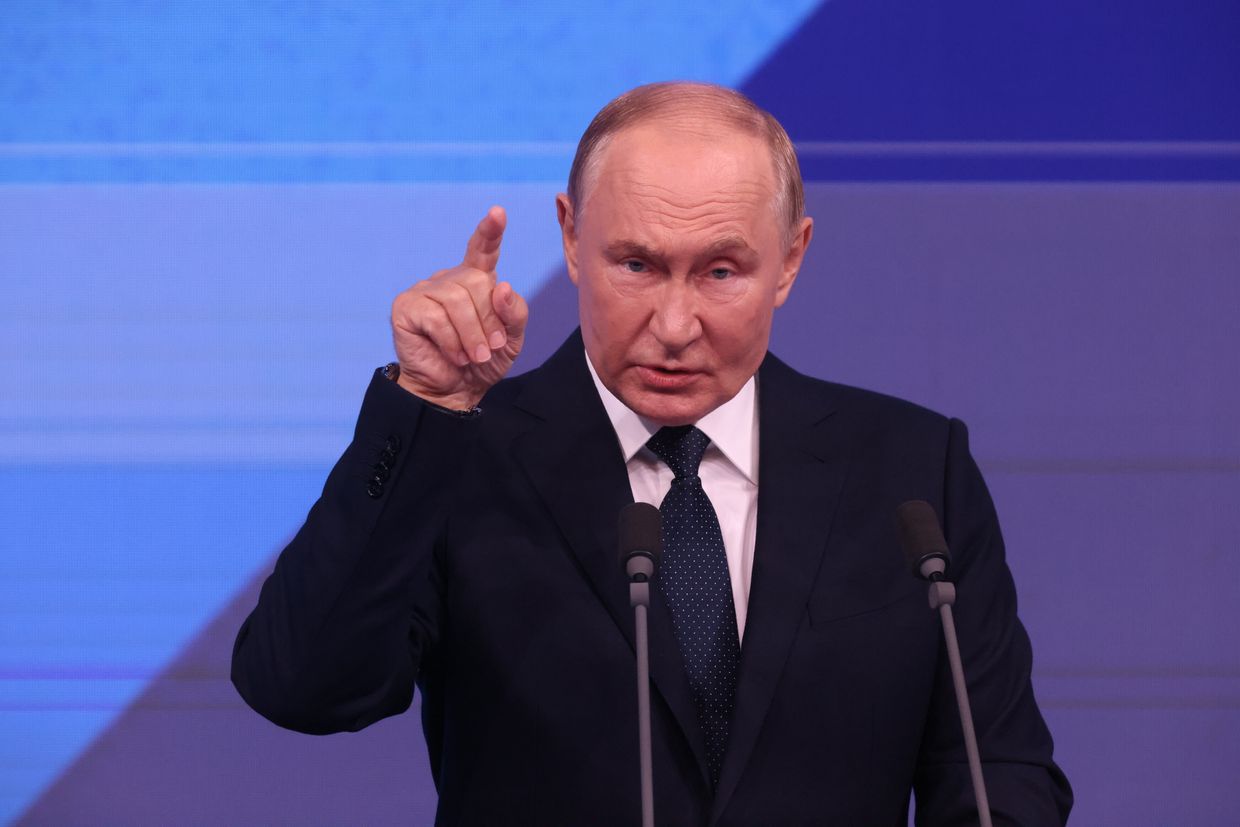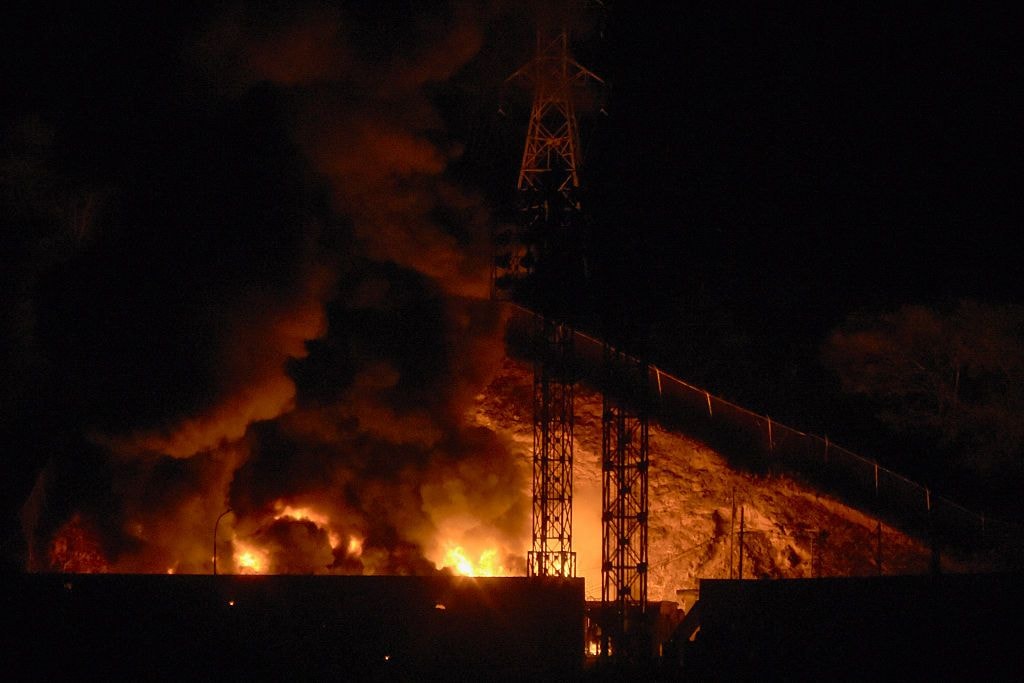
Opinion: Why Russia's memory policy in occupied territories leaves some Ukrainian monuments standing
Russia is not only destroying Ukrainian history and culture; its contemporary memory policy involves weaponizing Ukrainian history against Ukraine, rooting its geopolitical interests in antiquity. It is as if Russia’s struggle has a teleological purpose.
A statue of Ukrainian poet Taras Shevchenko, pockmarked with bullet holes, stands in the center of Borodianka, Kyiv Oblast, Ukraine, on June 8, 2022, amid Russia's war against Ukraine. (Les Kasyanov/Global Images Ukraine via Getty Images)

Vitalii Poberezhnyi
Journalist and producer
On the night of Jan. 14, 2023, a monument to the great Ukrainian poet Taras Shevchenko was dismantled from the central square of Melitopol, a Russian-occupied city in southern Ukraine. Ivan Fedorov, the exiled mayor of Melitopol, said Russian forces removed the monument to eradicate every trace of Ukraine in the city.
President Volodymyr Zelensky has made similar assertions. “Monuments and museums are destroyed in occupied territories, even if they barely remind one of Ukraine. They destroy books and do everything to incline people to renounce their national identity,” Zelensky said in a conversation with Chilean students.
However, some monuments to the Kobzar (Shevchenko’s pen name) remain standing in Russian-occupied parts of Ukraine, including Donetsk and Luhansk, which were occupied in 2014, as well as in Mariupol, Sievierodonetsk, Starobilsk, Tokmak, Nova Kakhovka, and Henichesk. Monuments to Shevchenko also exist in Crimea, including Simferopol, Sevastopol, and Yalta.
How does this align with Zelensky and Fedorov’s statements? What is the real Russian memory policy in the occupied east and south of Ukraine?
Many of these monuments were erected during the Soviet era, when Shevchenko was both a national and class hero, as many of his poems addressed the enslavement of Ukrainian peasants in the 19th century. Soviet propaganda depicted Shevchenko as a prophetic figure who inspired these peasants to fight for freedom. During that time, monuments to Shevchenko were established in Kyiv, Kharkiv, Odesa, and hundreds of other cities and villages across Ukraine.
In addition to Shevchenko, Soviet historians and literary critics included numerous other Ukrainian writers on the list of prominent communists, such as Ivan Franko, Lesya Ukrainka, and Mykhailo Kotsiubynsky. Notably, Russia has not threatened the memory of these figures. For instance, in April 2023, the Russian administration in Melitopol renamed several streets in the city. Their actions contradict Fedorov's assertion that Russia seeks to erase Ukrainianness entirely.
On one hand, many street names symbolizing Ukrainian history were changed. Dmytro Dontsov Street was renamed after Pavlo Sudoplatov. Dontsov was a Ukrainian nationalist thinker, while Sudoplatov was a Soviet agent known for assassinating the leader of the Organization of Ukrainian Nationalists. Both men were born in Melitopol.
Additionally, Melitopol saw the emergence of streets named after Russian Empress Catherine II, Alexander Zakharchenko (the head of the so-called “Donetsk People’s Republic,” the Kremlin’s name for Russian-occupied parts of Ukraine’s Donetsk Oblast), and Russian propagandist Darya Dugina. Many streets were restored to their names prior to the EuroMaidan Revolution (2013-2014), such as Maxim Gorky, Sergei Kirov, and Red Army.

On the other hand, streets named after Ukrainian luminaries Taras Shevchenko, Ivan Franko, and Lesya Ukrainka remained untouched in Melitopol. Furthermore, the Russian administration did not rename streets dedicated to Oleksandr Dovzhenko (a world-renowned Ukrainian film director), Hryhorii Skovoroda (the first Ukrainian philosopher), and Bohdan Khmelnytskyi (father of Cossack statehood). This suggests a deliberate policy rather than mere negligence.
“The Public Council, which included historians and public figures, carried out large and painstaking work,” said Galina Danilchenko, the head of the Russian occupation administration of Melitopol, in a Telegram post.
“(The Russian) occupiers say that Melitopol is a presentable city. Therefore, there’s a lot of illusion on the streets, such as buildings being painted, roads repaired, and playgrounds established. Flags on every pillar and a huge amount of leaflets and billboards. I haven’t seen such a level of propaganda in all my life,” an anonymous activist from the Ukrainian “Evil Mavka” resistance movement, which operates in Russian-occupied parts of Ukraine, said.
However, street renaming did not occur solely in Melitopol. In other occupied cities, streets named after Ukrainian literary figures mostly remained intact. In Starobilsk, streets dedicated to Ukrainian Soviet-era dissidents Ivan Svitlychny and Vasyl Stus were renamed, but Taras Shevchenko and Mykhailo Kotsiubynsky streets stayed the same. In Mariupol, streets named after Cossack Hetman Pylyp Orlyk and Ukrainian historian Mykhailo Hrushevsky disappeared, but the names of Taras Shevchenko, Lesya Ukrainka, and Panas Myrny were preserved.
To explain this dichotomy, let’s examine the Russian propaganda stance on Ukrainian history. Half a year before the full-scale invasion of Ukraine, Russian President Vladimir Putin published an essay titled “On the Historical Unity of Ukrainians and Russians.” In it, he revisits the millennial history of East Slavs, claiming that Ukrainians and Russians share a common origin and history.

“Taras Shevchenko wrote poetry in the Ukrainian language and prose mainly in Russian,” Putin asserts in the article. Thus, the Russian perspective holds that Shevchenko did not renounce Russia as a country but rather its authoritarian and conservative tsarist regime.
Putin claims that Ukrainians originally sought Russian patronage. In this context, he references Khmelnytskyi, Skovoroda, and Hohol. Those Ukrainians who wish to sever ties with Russia, according to Putin, are merely a marginal handful, inspired by external intrigue, particularly from the West. He cites figures like Ivan Mazepa (the Cossack statesman who rebelled against Russian rule), Symon Petliura (a politician in the Ukrainian People’s Republic), and Stepan Bandera (the leader of the Organization of Ukrainian Nationalists) as examples of such traitors.
The “dual identity” of Ukrainians is central to Putin’s concept. He posits that Ukrainians are rooted in two cultures simultaneously: one Ukrainian and the other Russian. This duality, according to Putin, is essential for Ukrainians to coexist harmoniously. Recognizing this allows us to understand the Russian logic behind street renaming. Almost all Ukrainians whose names were erased from urban spaces in Russian-occupied cities held strong anti-Russian views. Conversely, those whose names remain are seen as embodying this dual identity, even though many never expressed sympathy for Russia.
Consequently, the Russian memory policy regarding Ukraine is more complex than it may seem. Russia does not entirely erase the memory of Ukrainian history in occupied territories but rather reinterprets it through pervasive propaganda.
"Consequently, the Russian memory policy regarding Ukraine is more complex than it may seem. Russia does not entirely erase the memory of Ukrainian history in occupied territories but rather reinterprets it through pervasive propaganda."
These ideas are not a recent invention. In 2007, an 800-page book titled “Russian Doctrine” was published in Moscow, serving as a manifesto of Russian state ideology, written by prominent Russian intellectuals.
“We have to give up the ‘neo-Bolshevik’ practices used by Russian authorities in the 1990s that exaggerated differences between Russians, Ukrainians, and Belarusians,” the authors write in “Russian Doctrine.” By neo-Bolshevik practice, they refer to the policies of Boris Yeltsin's administration, which developed a partnership with Ukraine while not opposing its sovereignty. Putin, therefore, has returned to Stalin’s ideas, rooted in the Russian Empire’s policies toward conquered nations.
But what about Shevchenko? If Russia considers him part of its legacy, why dismantle the Kobzar’s monument in Melitopol?
Although sculptures of Shevchenko exist in many cities and villages in southern and eastern Ukraine, they rarely hold the status of central monuments in urban spaces. For instance, in Sievierodonetsk, a monument to Shevchenko was established in 1956 in a small square near the drama theater, while the central city square in front of the city council was dominated by a statue of Vladimir Lenin, a key figure in Russian communism. Similar situations occurred in many other cities.

More monuments to Shevchenko were erected after Ukraine gained independence, but their locations were often determined by what space remained available, as central sites were still occupied by monuments to Soviet heroes. In Nova Kakhovka, the first full-size monument to Shevchenko was erected in 2002. As in Sievierodonetsk, the sculpture of Lenin occupied the central square, so the Kobzar statue was placed in a park along the Dnipro River, a block away and somewhat obscured by foliage.
Melitopol is unique in this regard because, during the USSR, the main monument to Lenin was not positioned in the central square but on the edge of a major boulevard. The central square was left devoid of monuments until Shevchenko's sculpture was erected there in 2011, filling the void.
The sculpture maintained a prominent position in the central square, with Taras Shevchenko's statue on a high pedestal drawing the attention of passersby. Consequently, this monument became an eyesore for the newly established Russian administration, as the central square is intended for official ceremonies and celebrations, as well as for memorializing and glorifying key figures and narratives in Russian history, rather than secondary ones.
In October 2023, a new memorial, "City of Military Glory," was erected on the site of Shevchenko's sculpture. This monument featured a large mosaic panel depicting Red Army soldiers on the Eastern Front during World War II. Local governor Evgeniy Balitsky announced that the Shevchenko monument would be relocated to a less prominent site. However, activists from the “Evil Mavka” resistance movement reported that they have not seen the sculpture since its removal from the central square, and its whereabouts remain untraceable through open sources.
While Kobzar may be considered a secondary historical and cultural figure in present-day Russia, he can never be central. Ukrainian heroes are expected to hold a lower status than their Russian counterparts, as was the case in the USSR. This is why the narrative of World War II is so prominent; the victory of the Red Army over the Nazis symbolized the unity of various Soviet nations under the Kremlin’s leadership in defending their Motherland.
"While Kobzar may be considered a secondary historical and cultural figure in present-day Russia, he can never be central. Ukrainian heroes are expected to hold a lower status than their Russian counterparts, as was the case in the USSR."
Ultimately, the Russian colonial doctrine aligns with a real-time memory policy. Russia intensively renames streets, paints murals, and erects monuments in occupied cities. What Putin might term “denazification” is unlikely to be acknowledged as “de-Ukrainianization.” The stated aim of Russia’s so-called “special military operation” is not the extermination of Ukrainians but rather the restoration of Ukraine to its origins.
This policy of soft influence and historical reshaping is not a reflection of Putin’s quest for historical justice; it has proven effective. Fostering alliances with Ukrainians offers more advantages than attempting to eradicate them. Stalin, for instance, offered enticing career opportunities to the Ukrainian elite in exchange for absolute loyalty, later utilizing Ukrainian intellectuals to mobilize the populace against Hitler. Writers and poets inspired the “Ukrainian Soviet nation” to resist Nazi occupation through patriotic verses and stories.
Russia is not only destroying Ukrainian history and culture; its contemporary memory policy involves weaponizing Ukrainian history against Ukraine, rooting its geopolitical interests in antiquity. It is as if Russia’s struggle has a teleological purpose.
After all, could there be a more cruel enemy to Ukraine’s fight for independence than a Kobzar playing the balalaika?
Editor’s Note: The opinions expressed in the op-ed section are those of the authors and do not reflect the views of the Kyiv Independent.












